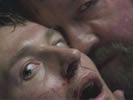Eye For Film >> Movies >> Dying Breed (2008) Film Review
"Look at this place. There are places out here nobody's ever seen before. Ever."
So says Irish zoologist Nina (Mirrah Foulkes), recently come on an expedition to Tasmania's backwoods both to find proof the Tasmanian tiger is not entirely extinct, and to reconcile herself to the mysterious death of her sister there eight years earlier. Nina fantasises that the wild bushlands and rocky caves all around are terra incognita, whereas her boyfriend Matt (Leigh Whannell, writer and star of the original Saw) knows better, having noticed the empty beer bottle at their campsite.

Indeed, the couple and their fellow travellers Jack (Nathan Phillips) and Rebecca (Melanie Vallejo) are about to discover that they are not alone, and that folk directly descended from one of the darker episodes in Australia's early colonial history have long been using these supposedly virgin territories for their hunting, breeding and feeding grounds.
The white history of Australia – and more particularly of Tasmania, or Van Diemen's Land as it was first called – is full of horrors. Even if you entirely overlook – as this film does – the extermination of the aboriginal population by settlers, the island's original status as a draconian dumping ground for British convicts ensured that it was a place of unspeakable inhumanity. Real-life prisoner Andrew Pearce managed to abscond from two different penal settlements during his stay there, and was eventually hanged in 1824 after having lived off the flesh of his fellow escapees, even when other food was available to him.
This notorious slice of local history has been cannibalised in Jody Dwyer's Dying Breed, which presents us with Pearce's inbred and somewhat bestial descendants, and leaves it to our imagination how Pearce himself, on the run and far from any women, could ever have come to have children. Let's just say that while the film never quite becomes a full-blown creature feature, the Tasmanian tigers being pursued by Nina are no mere macguffin, but are implied to be at the very centre of Dwyer's hybrid horror. "When a bitch is on heat," as local Liam (Ken Radley) so charmingly suggests, "she'll go out of her way to find a mate"; and his words take on a special resonance when we remember (as this film expressly reminds us) that Tasmanian tigers looked far more canine than feline.
If Geoffrey Hall's cinematography is eerily beautiful, capturing the isolation and subdued menace of the Tasmanian hinterlands, then there is little else in the Dying Breed that, to quote Nina again, "nobody's ever seen before". For Dwyer has taken this cinematically uncharted landscape and, like the convict runners of old, transported to it all manner of unsavoury foreign elements.
Everyone is broadly familiar with the whole cityslickers vs rednecks dynamic, while horror connoisseurs can tick off the more specific references to Deliverance (1972), The Texas Chain Saw Massacre (1974), The Hills Have Eyes films (including the 2007 sequel to the 2006 remake), the Wrong Turn films, and Timber Falls (2007). Even hoary old horror clichés, like the creepy little girl, the comedy cops, or the foot caught in a mantrap, get a look in here.
In a sense such derivativeness hardly matters – for as one character (Bille Brown) puts it near the end of Dying Breed, "We have a life to protect, a tradition." It may hardly be original, it may even seem impure and incestuous – but this film's bloodline taps right into a long tradition of horror. Plenty of blood on the wattle, too, for any gorehounds, striped or otherwise, out there. Still, like any hidden history, Dwyer's film seems likely to go largely unnoticed – and perhaps, given how little new it brings to the table, that is no bad thing.
Reviewed on: 12 Mar 2009

















